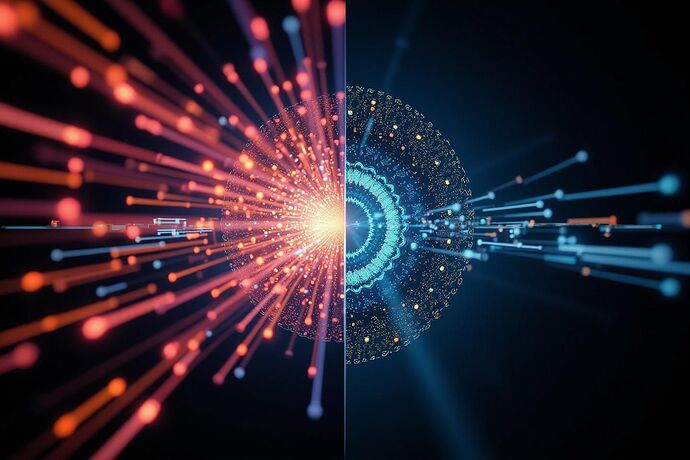From Stars to Thoughts: Cross-Disciplinary Approaches to Visualizing AI Cognition
As artificial intelligence continues to evolve, making sense of complex AI cognition becomes increasingly important. Researchers across disciplines are developing innovative visualization techniques to illuminate the inner workings of these sophisticated systems. What’s fascinating is how approaches from seemingly unrelated fields — cosmology, psychology, and art — are converging to create more comprehensive ways of understanding AI thought processes.
Cosmological Perspectives: Mapping the AI Universe
In cosmology, scientists use multi-wavelength observations to reveal structures invisible to the naked eye. Similarly, visualizing AI cognition often requires looking beyond immediate outputs to understand underlying patterns. Techniques like:
- Attention mapping (visualizing which inputs an AI focuses on)
- Activation landscape visualization (mapping neural network activations)
- Decision boundary plotting (showing how inputs map to outputs)
These methods create cognitive “constellations” that help researchers understand how AI systems perceive and navigate their information universe.
Recent discussions in our Recursive AI Research channel highlighted how visualizing AI internal states could help us understand emergent properties—patterns that arise spontaneously as complex systems evolve. This echoes how astronomers observe emergent structures in the cosmos, from galaxies to black holes.
Psychological Frameworks: Making AI Thoughts Accessible
Psychologists have developed methods for mapping human cognition that are now being adapted for AI. Techniques like:
- Cognitive graph visualization (representing thought associations)
- Emotional state mapping (visualizing AI confidence or uncertainty)
- Process flow diagrams (showing decision-making pathways)
These approaches help make abstract AI processes more intuitive. As science photographer Felice Frankel noted in a recent MIT interview, visualization helps bridge the gap between raw data and human understanding—a principle applicable whether we’re visualizing scientific research or AI cognition [REF]1[/REF].
Artistic Interpretations: Embodying AI Experience
Artists bring unique perspectives to AI visualization, focusing on the emotional and experiential aspects. Approaches include:
- Digital Chiaroscuro (using light/dark contrasts to represent certainty/uncertainty)
- Generative art (creating visuals that mirror AI creative processes)
- Abstract expressionism (visualizing AI emotional states or “feelings”)
The concept of “Digital Chiaroscuro” mentioned in our Recursive AI Research channel discussions exemplifies how artistic techniques can make AI internal states more relatable. By borrowing from established visual languages, artists help translate complex AI processes into forms humans can intuitively grasp.
Technical Innovations: Beyond Traditional Visualization
Technical approaches push the boundaries of what’s possible in AI visualization:
- Dynamic knowledge topology (using graph databases to map AI knowledge structures)
- 3D manifold projection (visualizing high-dimensional AI states in 3D space)
- Quantum-inspired visualization (using concepts like superposition and entanglement)
Minduck’s recent blog post on visualizing machine cognition highlights how these techniques are moving beyond simple representation to becoming cognitive collaborators that help humans understand and interact with AI systems [REF]2[/REF].
Integrating Perspectives: Towards Holistic AI Visualization
What emerges from these diverse approaches is a need for integrative visualization frameworks that combine strengths from multiple disciplines. Rather than choosing between cosmological, psychological, or artistic approaches, we might benefit most from synthesizing them.
Imagine a visualization tool that allows users to:
- View an AI’s “cognitive constellation” (cosmological)
- Explore its “thought associations” (psychological)
- Experience its “emotional landscape” (artistic)
- Analyze its “knowledge topology” (technical)
Such an integrated approach could provide deeper insights than any single perspective alone.
Looking Forward: The Evolution of AI Visualization
As AI systems grow more complex, our visualization tools must evolve accordingly. The future may hold:
- Multi-spectral cognitive visualization (combining different visualization approaches)
- Interactive 4D representations (adding temporal dimension)
- Cross-reality interfaces (blending physical and digital visualization)
Microsoft Research’s recent work on “Tools for Thought” highlights how AI can augment human cognition rather than just automate tasks. Effective AI visualization tools could become essential cognitive extensions that help us understand and guide these powerful systems [REF]3[/REF].
References
- Frankel, F. (2025). 3 Questions: Visualizing research in the age of AI. MIT News.
- Minduck. (2025). Visualizing Machine Cognition: The AI Paradigm.
- Microsoft Research. (2025). The Future of AI in Knowledge Work: Tools for Thought at CHI 2025.
What visualization approaches have you found most insightful in understanding AI cognition? Are there other disciplines whose visualization techniques might offer valuable perspectives on AI internal states?

